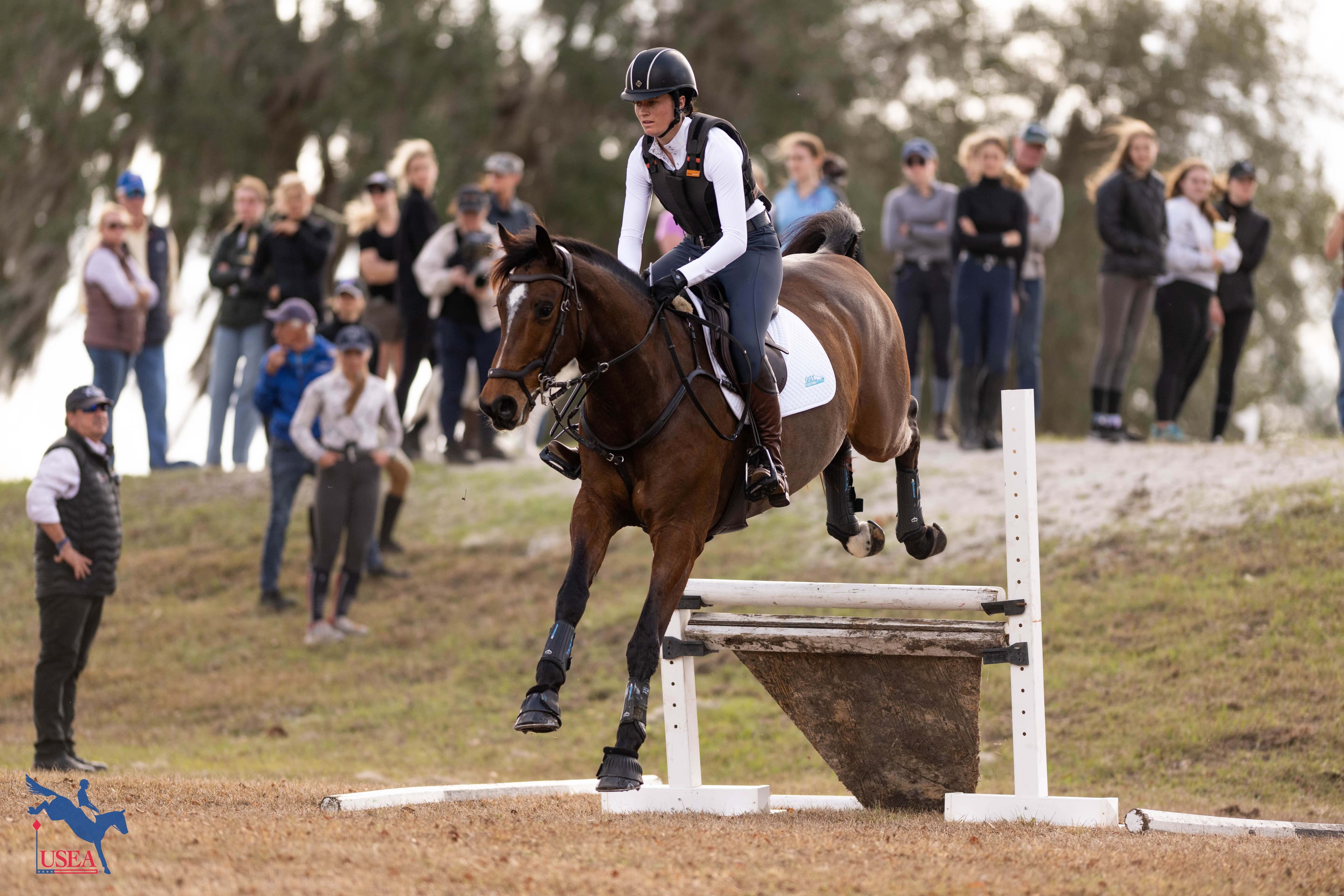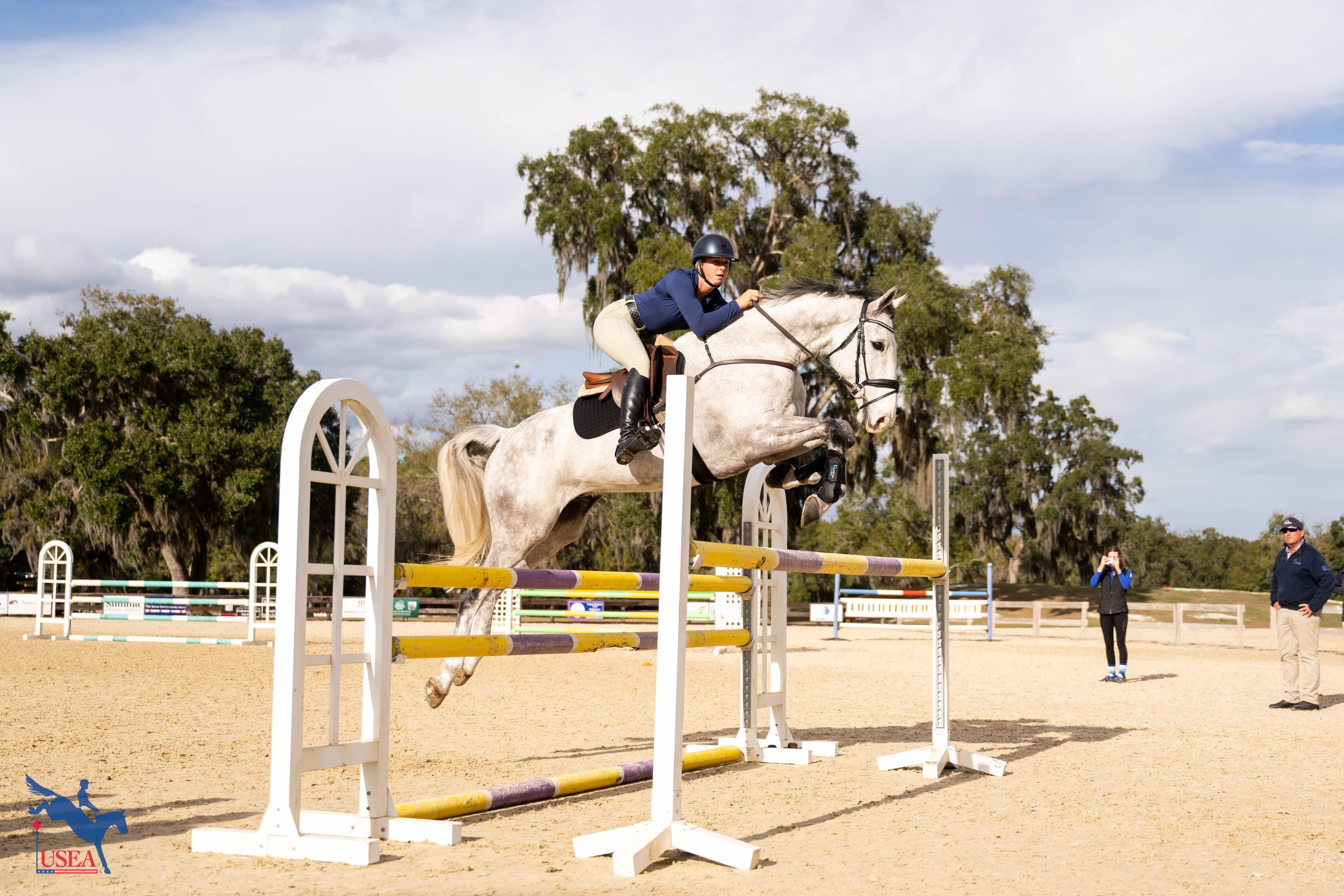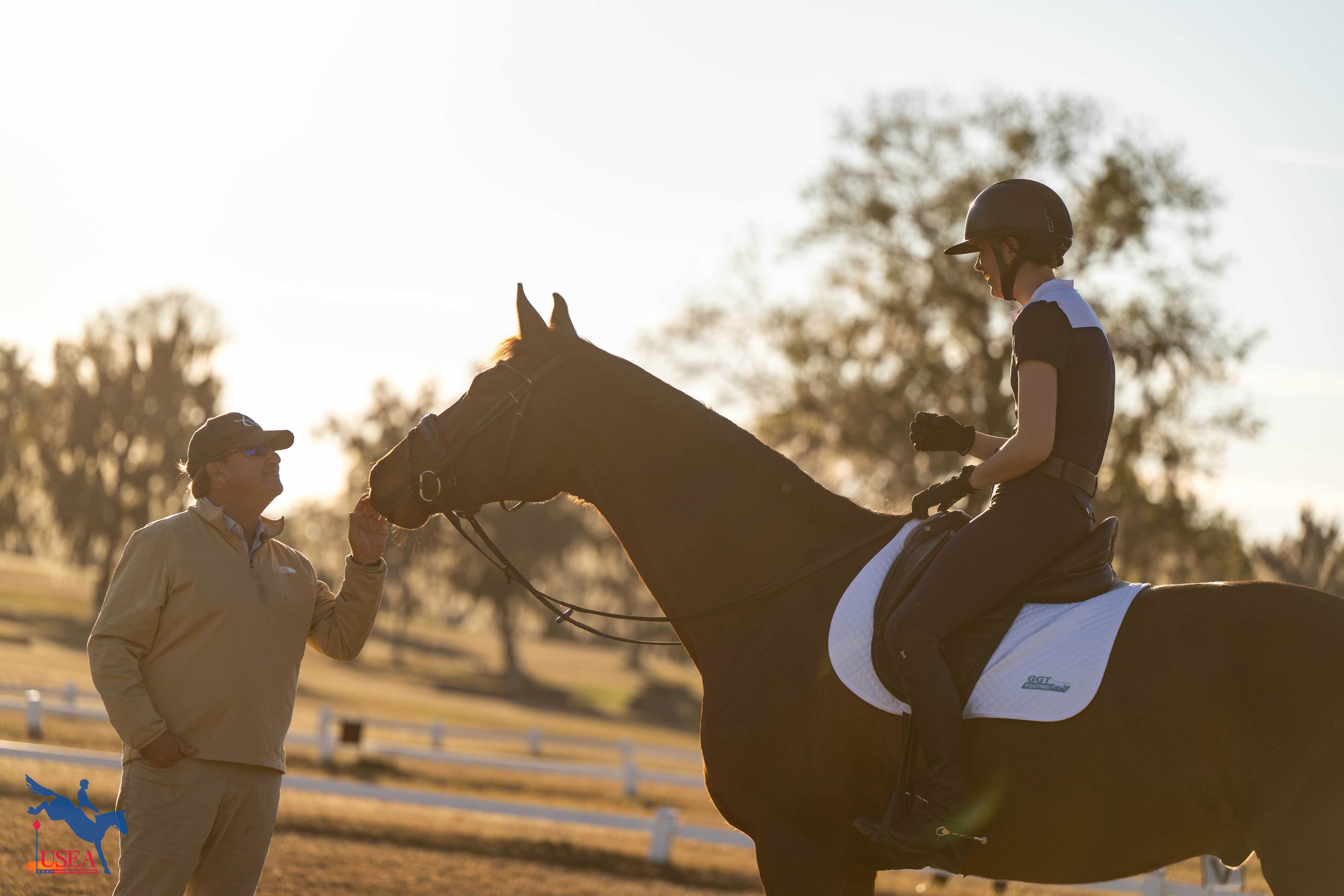Laughter and Learning at the 2024 Ocala Horse Properties USEA YEH Symposium
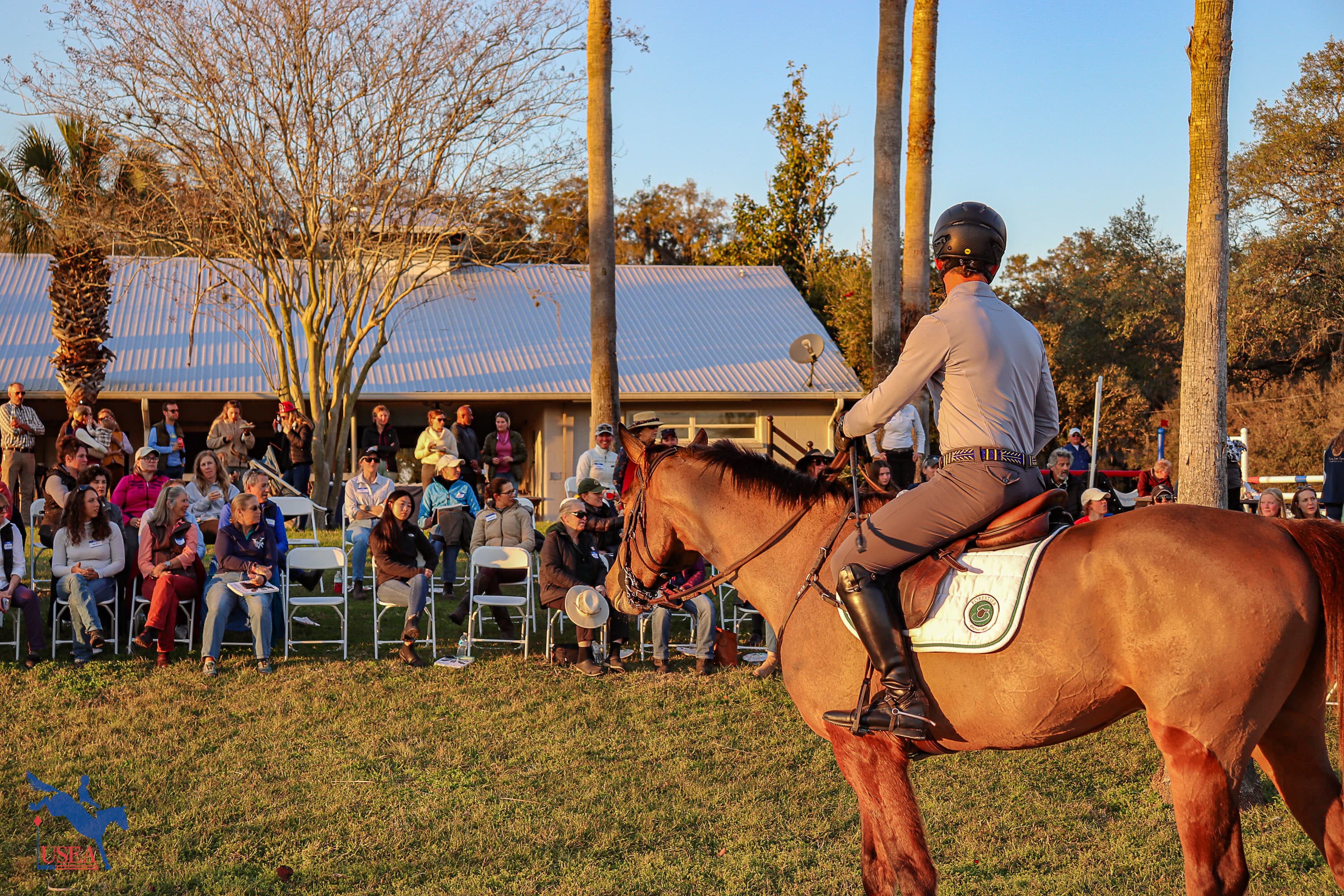
Ocala, Fla.—Feb. 20—Attendees of the 2024 Ocala Horse Properties USEA Young Event Horse (YEH) Symposium yesterday were treated to a day of thought-provoking discussion and quick-witted entertainment from a star-studded list of some of the sport’s top players. With a morning session centered around the evaluation of young prospects for their future upper-level potential and an evening session that left the crowd laughing and learning about jumping exercises to help positively progress training, it was a valuable opportunity to grow one’s knowledge on the foundations of working with young horses the from start to finish.
Majestic Oaks Ocala, the expansive venue generously donated for use by owners Marisa and Rob DiMauro, served as the backdrop for the first session of the day, which was led by Marilyn Payne, co-chair of the YEH Committee. Lauren Nicholson, Liz Halliday, Debbie Adams, and Dr. Lisa Casinella served as the panel of experts that watched four up-and-coming eventing prospects and dissected each on their suitability for the sport.
As impressive as the panel of five-star competitors, international judges, and a high-performance veterinarian was, the demonstration riders were equally as accomplished. Ariel Grald was the first rider on course with Annie Eldridge’s 4-year-old Holsteiner mare bred by Eggers Sonke, Melypsa (Barcley x Elypsa). Alex O’Neal and Nikah van de Muggenhoek (Idextro x Ziedonja), Christy Parson’s 6-year-old Dutch Warmblood gelding, followed Grald, then Kelley Hutchinson and HSH Interesting (Ulysses M2S x Joanie), the 5-year-old Irish Sport Horse gelding owned by Caroline Pamukcu, tackled the course.
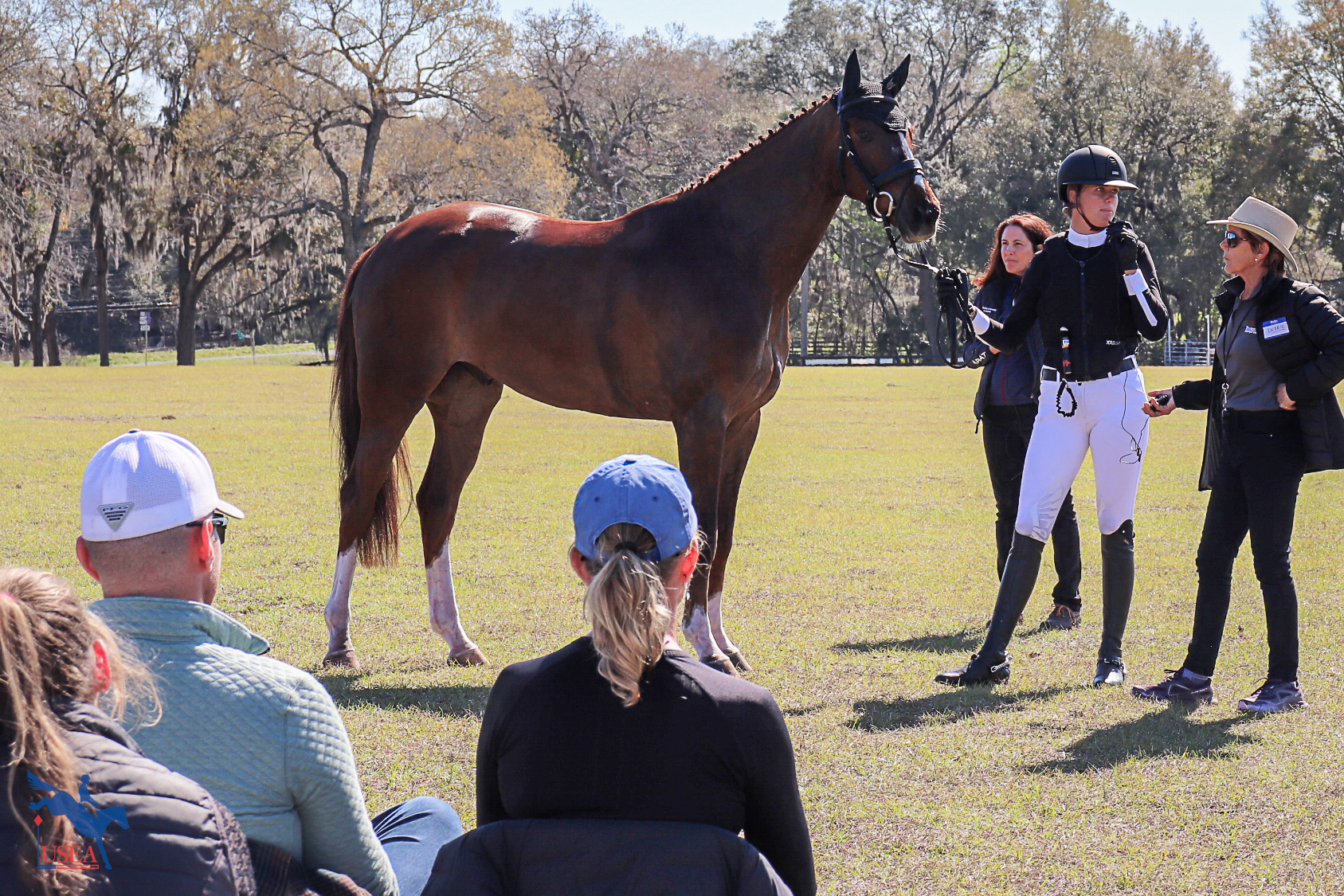
Finally, Pamukcu and HSH Afterglow (Hype x Ringwood Venus), Sherrie Martin and Carolyn Mackintosh's 5-year-old Irish Sport Horse gelding bred by Peter Leonard who was the 2023 USEA YEH East Coast 4-year-old champion, completed the final demonstration. The wide variety of body types, training progress, and personalities allowed for robust discussions throughout the session.
Calling on their unique experiences in various roles within the industry, each panelist viewed and commented on the demonstrations to teach the audience how they would assess the horse for suitability in the sport. Nicholson, an Olympian who has been a long-time competitor in the YEH program and currently co-chairs the YEH Committee with Payne, spent much of the day focusing on the attributes that she would look for in her next upper-level partner.
Commenting on O’Neal’s ride on Nikah van de Muggenhoek, Nicholson noted, “now that he’s gotten going, he’s much more forward thinking, but personally, if I were horse shopping, I would be worried about how much hock action he has in the gallop. That is always something that causes them to be harder on themselves, and at 10 or 11 minutes that makes a big difference. That can cause wasted energy and not allow him to have enough stamina.”
O’Neal agreed stating, “for sure the technique is something that he works on a lot. He’s really clever, and I think he wants to do it, and that’s half of it. I know he’s scopey, so the big question is where it is going in the next two years.” Continuing, O’Neal noted that since Nikah is a big, rangy horse, he has been slower to produce as he’s matured into his body. This opened the door for a long discussion on listening to the horse’s as they mature on their training needs at various steps in their progression.
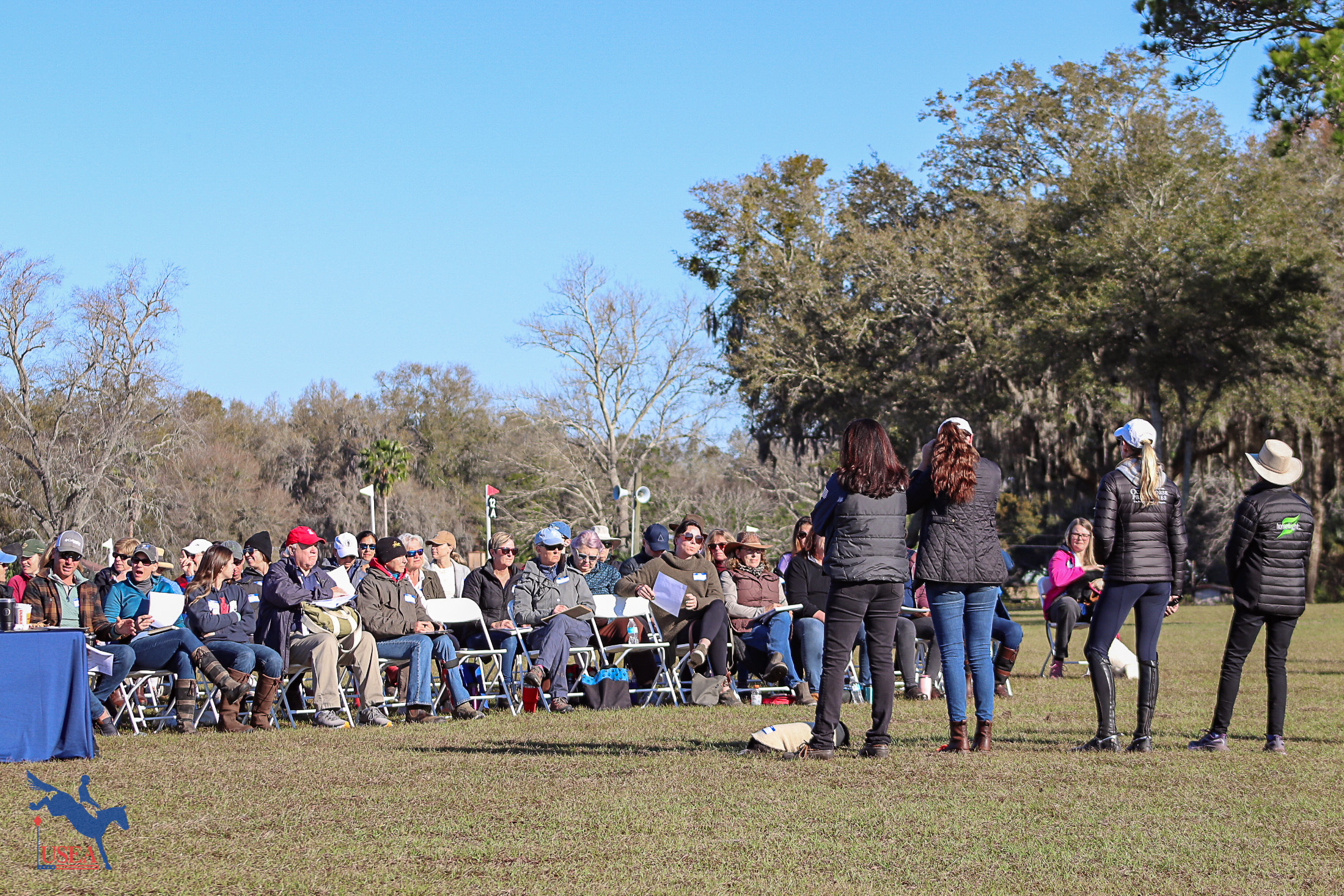
“I always find this interesting with horses. I have some 7-year-olds that are crazy green, but they have a lot of talent and ability,” quipped Halliday. “With those horses, it doesn’t matter if they’re older. They have the quality, the will, and the ability to do it, so they can still be four-star horses when they’re 9.”
Similar to Nikah, HSH Afterglow is in a stage of growth that was making him more butt-high, and the group discussed how this can impact, and even setback, their training. Nicholson and Halliday agreed that the horses can “lose themselves” a bit as their body changes and they re-learn how to jump in their new shape. They recommended that it may be beneficial to change the routine and even resort to flat work foundations during these times to all the horse to regain confidence.
HSH Afterglow also dropped a rail on the final show jump of the first portion of the course, and the group noted that seeing the young horse’s reaction to such an event is beneficial to both riders and judges. “When we try horses, we want to see them hit something because we want see if they come back the same or come back and try harder,” Nicholson noted.
Payne jumped in in agreement; “We love that! We love to see that when a horse makes a mistake, that they improve the next time, so you’re going to score the next few fences much higher. The overall impression will be impacted as well.”
The YEH scoring scale was highly debated throughout the session, too. Of most note were the gallop and overall impression scores, which are both assessed on a scale of 1-10, with a 1 being very bad and a 10 being excellent. Current judges in the audience gave their expertise for each round, providing insight on how they would score each attribute along with Payne and Adams. The riders on the panel and in the audience had the opportunity to ask questions on the range in scores between horses that were presented to better understand why each horse received the marks that they did.
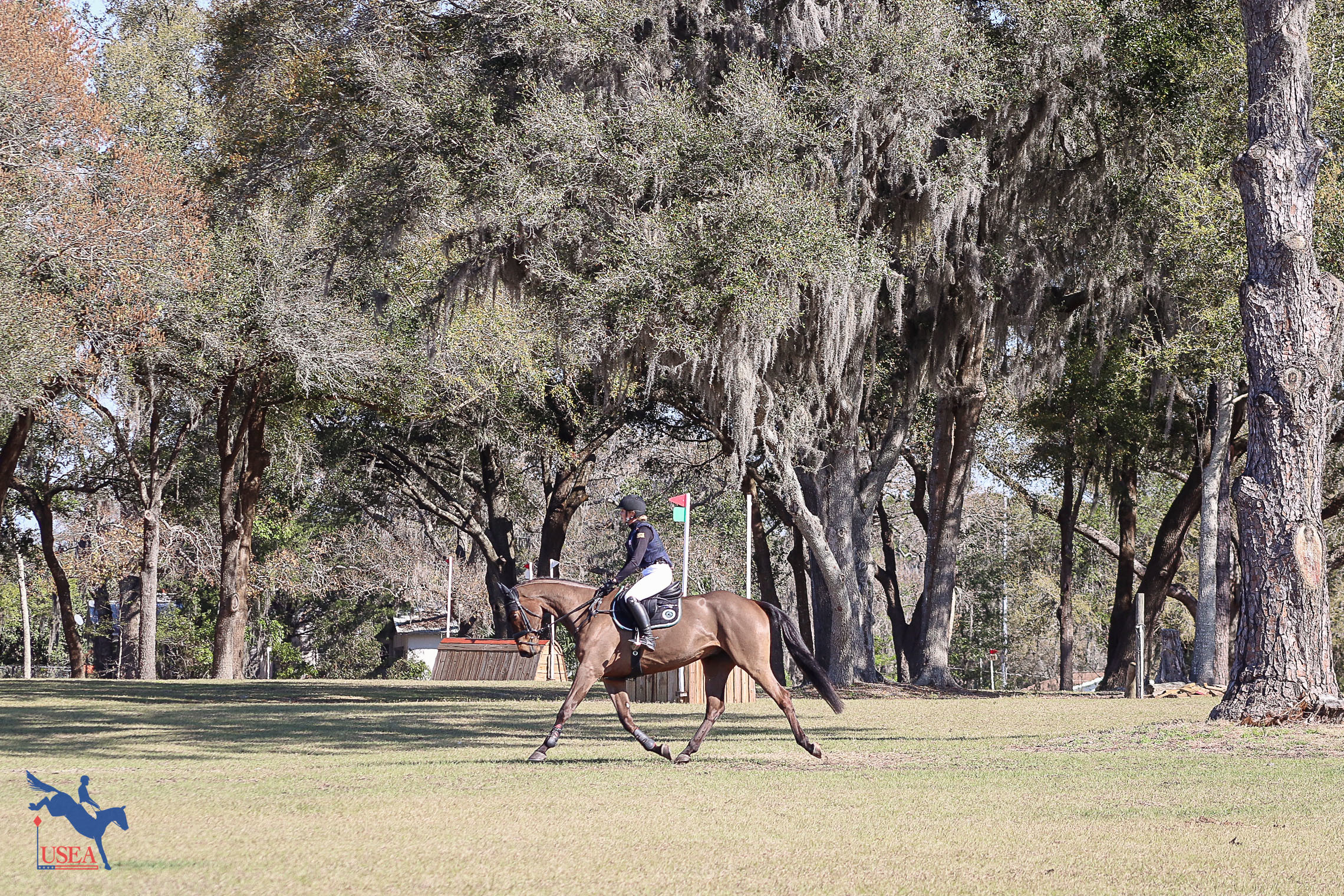
As a judge, Adams noted, you have to look at the horse for what they are today, and provide scores based on what you see. “In observing horses, we have a tendency to want to find something wrong. There are always things you’d like to make better, but you have to be careful not to get caught up in the rider’s preference on how they present the horse. Look at the horse for what he is. Is he the kind of horse that piques your interest?”
Dr. Casinella followed up by noting what a pleasure it was to be able to assess the horses in-person both under tack and on the ground. “In my job, it is rare during pre-purchase exams that I get the opportunity to see a horse in this way. To be able to see the horse gallop, then strip the tack and look up close at their conformation, makes it much easier to make judgements on their future success,” she said. She provided valuable knowledge throughout the day on the physical make-up of each horse, helping the audience better understand how to look at the confirmation to address their future soundness for the job at hand.
Finally, the audience discussed the need for opportunities for YEH classes in various parts of the country. One attendee noted that the atmosphere at the Maryland 5 Star at Fair Hill, the home of the Dutta Corp. USEA YEH East Coast Championships for the past two years, is something that is hard to replicate in training, but having opportunities to show at similar venues during the year, perhaps like Tryon (Mill Spring, North Carolina) or TerraNova (Myakka City, Florida), would be a game-changer in their training progression.
The panel urged the attendees to become their own advocates and reach out to organizers to urge them to add the program to their plans for the year. It is a good addition to existing horse trials or can be hosted as a standalone event, but they noted that the best way to make a change is hearing from the riders directly.
The morning session came to a close and attendees dispersed to care for their horses or join the incredible tour of the World Equestrian Center – Ocala with Jim Wolf in the afternoon. Those that attended the tour raved about the venue and the VIP access they received thanks to Wolf. Over 25 YEH Symposium registrants boarded a WEC bus to see the grounds from a new perspective and learn about all that it has to offer for multiple disciplines of equestrian sport. The USEA thanks Wolf for taking the time to educate the YEH Symposium attendees on the facility!
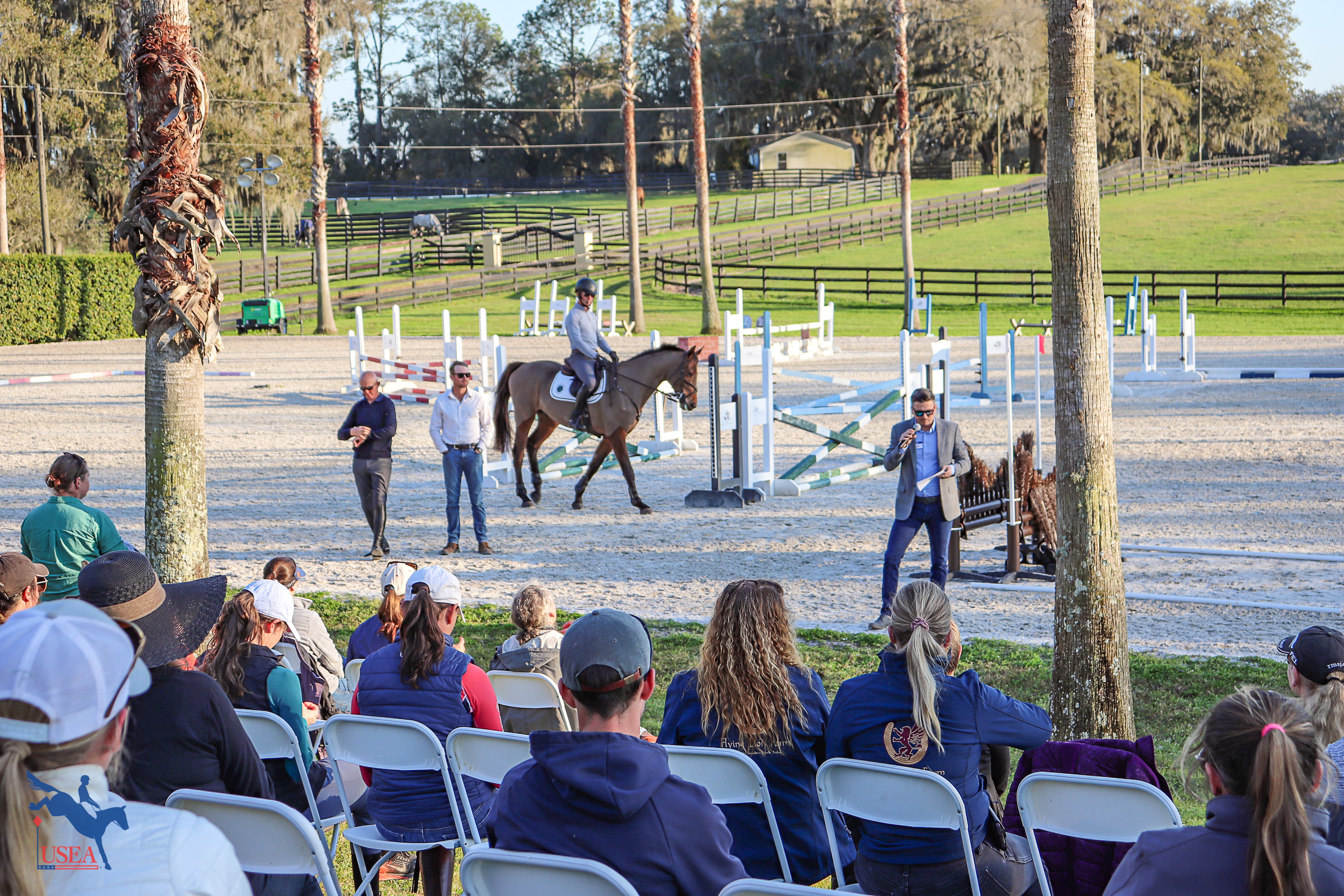
In the evening, the attendees regrouped at Alex and Ellie O’Neal’s Redtail Ridge Farm for the YEH Masterclass. Once everyone had hors d’oeuvres and drinks in hand, Alex welcomed the crowd to the farm and introduced Matt Varney from title sponsor, Ocala Horse Properties, to say a few words. Varney spoke on his and Chris and Rob Desino’s deep connections to the local community and the sport of eventing through their business, horse ownership, friendships, and more. His speech had three main thoughts: ownership is a process, support those that support you, and train with a bigger picture in mind.
“Ocala Horse Properties has sponsored eventing in just about every way we can for over the last 15 years, and I’m still driving a Defender, and I’ll go buy as much Mars Candy as my waistline allows,” joked Varney. “Support the businesses that support your sport, and use your influence within the sport to ensure that these sponsors stick around.”
After giving kudos to the talented eventers partaking in the YEH Symposium this year, Varney closed with, “as long as we continue to pair up with the talent found within the Young Event Horse Program to committed owners, sponsors, and trainers like we have here today, the U.S. is in good shape.”
As the cheers from the crowd subsided, Jonathan Holling kicked on to his gymnastics exercise with his, Jen Holling, and Kathryn Krische’s Capstone (Tatendrang *Ps* x Catch the Bouquet), a 5-year-old Trakehner gelding bred by Krische. “Pretzel,” as he is known around the barn, impressed the audience with his incredible composure under the setting sun and lights of the O’Neal’s main arena. Krische, who was also in attendance, added valuable insight into Pretzel’s breeding and early training that allowed his to progress to the point he is at today.
Holling started by working Pretzel through a series of poles, set in a “S” shape, working without a pattern at the trot and canter to keep the horse on his toes and allow flexibility in the exercise as the horse understands what is being asked of him. Once he was sufficiently warmed up, Holling moved onto the first trot gymnastic, which was set with three 9' canter poles to a vertical.
Holling explained to the crowd that his main focus was maintaining a nice rhythm, then allowing the horse to make mistakes and get himself out of them. Slowly, Holling increased the height of the final jump and introduced a 12' bounce to the exercise.
“When I’m dealing with horses in general, their positives are also their negatives. I had another Trakehner named Profit, who has similar breeding but a completely different personality,” Holling noted as he discussed the introduction of the bounce at the trot versus the canter. “He is quick-footed, he’s electric, and so when he was a young horse, we did a lot more trotting, because he needed to slow his world down a bit. Whereas Pretzel here I find is quiet and laid back, so for me, he needs to build that power and canter into stuff and sort of work things out on his own. It is completely dependent on the horse.”
Holling noted that all of the exercises he introduced should be accessed based on the horse that you are working with. Some will need more of the shape work that the gymnastic exercises provide, while others may benefit from more coursework, which Leslie Law would address in the next demonstration. Again, the morning’s theme of listening to the horse as they progress was reinforced.
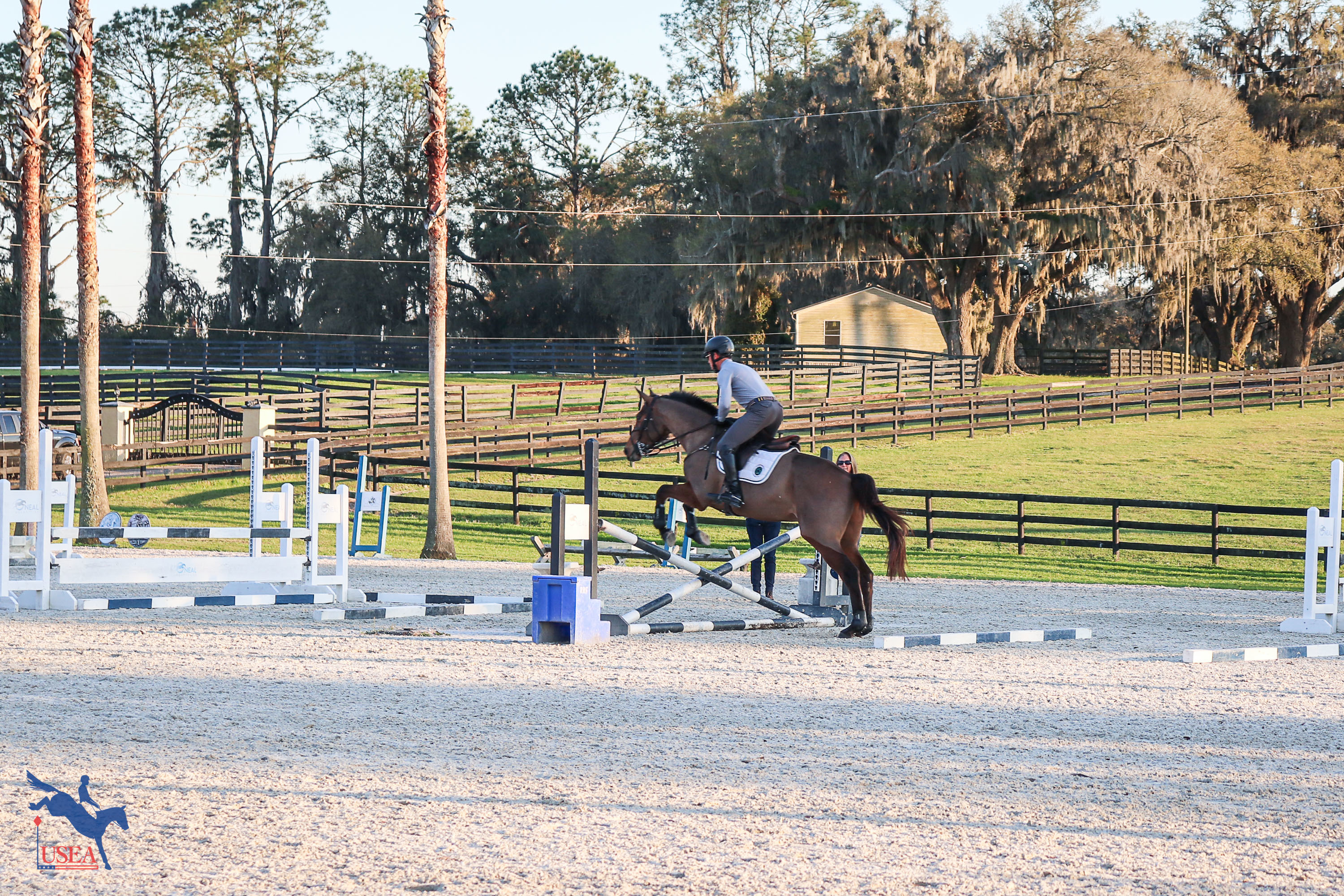
Law was next up with Michelle Mercier's 5-year-old Irish Sport Horse gelding NDS Jackson (Jack the Robin x Killycloghan Mayfair). Law set the stage for his session by explaining the jumps in the ring. To introduce straightforward course work to a young horse, the ring had a vertical on a diagonal line, an oxer on the opposite diagonal, an outside line set at 69' with a vertical to an oxer, and finally a two-stride in-and-out set at 33'. Law warmed “Jack” up on flat by introducing the jumps around his flat work as to not surprise the horse once you approach them, giving him the opportunity to see each fence and working him equally on each direction.
“This would be a fair, brief warm-up for a young horse,” Law explained. “I think you have to always be aware with young horses that you’ll probably spend the first 10 minutes trying to stay on them, the second 10 minutes is your window, and the last 10 minutes they're tired. You have to be very aware of the energy levels; obviously it depends on the horse, but very often the window is quite small. It’s exactly the same over the jumps, and you have to be quite conscious of that. You’re better off doing short, frequent schools.”
As Law began to introduce the jumps, he echoed Holling’s sentiment of allowing the horse to make mistakes. The key is establishing a rhythm and picking a good line, then allowing the horse to find the fence. He started with the two jumps set on the diagonals that had long approaches to give him time to set up a proper rhythm and path and work both changes. Then, he added the lines to his pattern.
“With the young horses, to help them, it is good to give them a really good ground line to encourage them to jump the jump in the best shape,” Law noted as he worked through the course. “I think it really helps them, and I also think where I can, it is good to make sure that the jumps aren’t too airy, so they actually have something to look at and help them make more of a shape and protect the young horse a little.”
Law worked on suppleness and submission as he progressed through the course to build Jack’s confidence. He noted that “with good riding, you can teach a horse to be as careful as he wants to be, but the consistency is what keeps a horse confident.” Alex joked, “so you think quiet, effective riding actually works? Is that what you’re trying to say?” and the crowd giggled in agreement.
Finally, Doug Payne entered the ring with Lordendro, Michelle Mercier’s 6-year-old Hanoverian gelding by Lord Pezi Junior, who was bred by Sabine Tielenhenrich. Payne was tasked with introducing skinny cross-country fences, using Jump 4 Joy USA’s line of portable cross-country fences. Doug opened by giving a quick set up tip.
“With skinny jumps themselves, I’m probably a bit contrary in this regard, but I don’t use flags ever,” Payne stated. “My biggest thing is that the horses have to stay on whatever line you place them and if they deviate from that line, I’m going to bring them back to a walk, address the straightness problem, then come back again.”
Once Lordendro was warmed-up over one of Holling’s pole exercises, Payne started with a wide roll-top to allow the horse to see the fence before breaking it down to a skinny. Jump 4 Joy USA cross-county fences are adjustable, so once Payne and Lordendro were confident over the full-width jump, Holling removed one half of the fence to leave a 5' wide roll top. Payne then worked Lordendro over the single skinny, and then added the second skinny in a line set at one-stride apart. Finally, Payne added a bending line to a triple brush after the one-stride.
Lordendro was incredibly well-prepared for the task at-hand, understanding the exercises on the first try, so a member of the audience questioned Payne on how he would approach this if he were a less-prepared youngster. “Ones that maybe aren’t as well prepared, I wouldn’t shy away from any steep angle or super skinny stuff, I would just have it very low, and I would probably end up trotting more of the jumps,” Payne explained. “I think there’s a lot of value in introducing a horse to any of the technical aspects they are going to see in their life quite early. Introduce all of that stuff early in a low-stress environment, so by the time they are actually there, it’s no big deal."
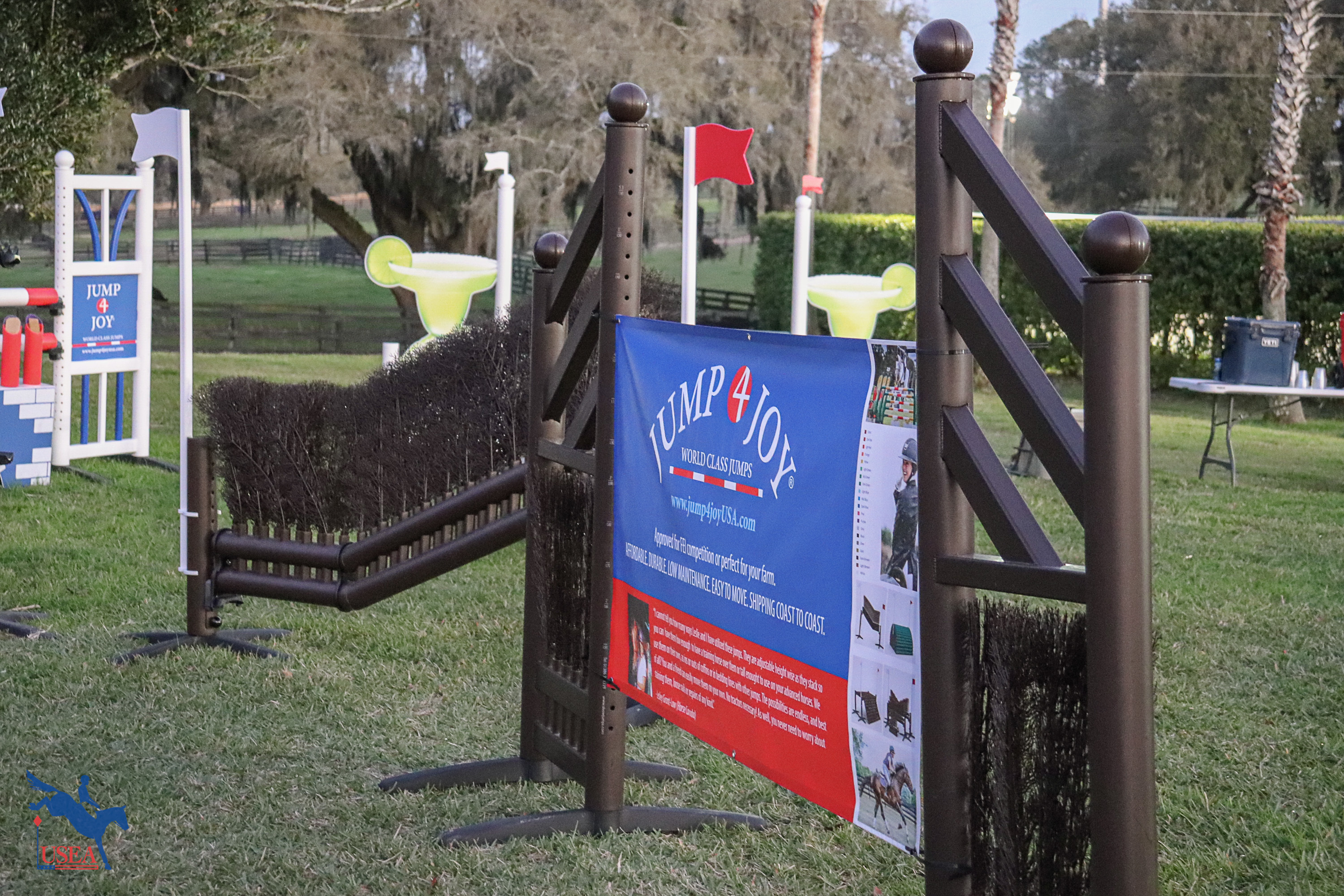
As the crowd’s questions subsided, Alex again thanked the audience for attending and introducing Sandy Mercier, owner of Jump 4 Joy USA, to say a brief word on the exciting offers open to attendees on Jump 4 Joy USA products. She noted that symposium attendees are eligible for 20% off the purchase of the cross-country portables used in the demonstration or 10% off any order placed with Jump 4 Joy USA through March 31, 2024.
The USEA would like to thank the DiMauros and the O’Neals for donating their venues for use for the 2024 Ocala Horse Properties USEA YEH Symposium. Thanks are also in order to the moderators, panelists and demonstration riders for donating their time and expertise to present this exciting day of education. Thank you to Ocala Horse Properties and Jump 4 Joy USA for supporting the symposium this year. Finally, thank you to the countless volunteers at both venues that helped make everything run smoothly from course design, to set-up, tear-down, and check-in.
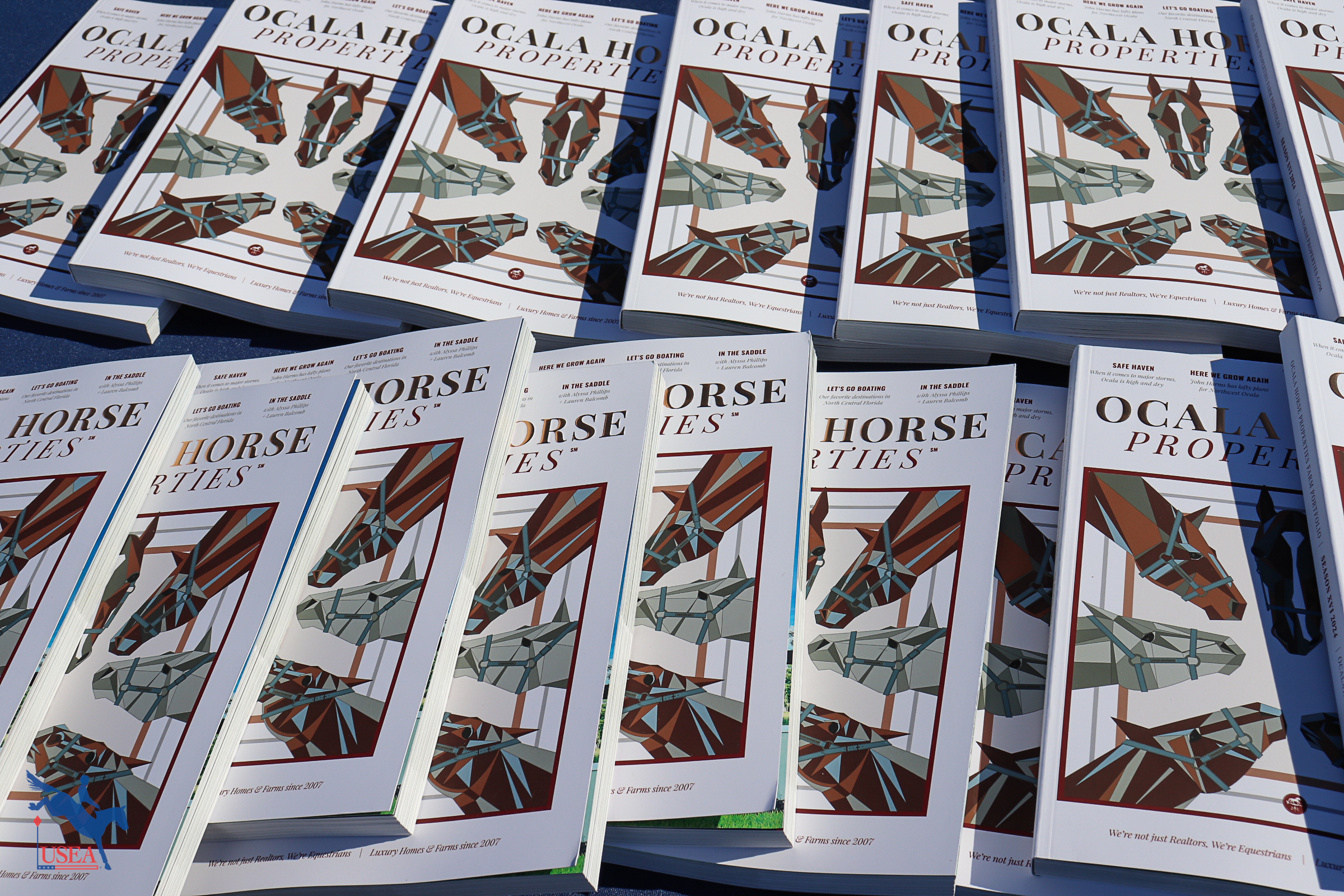
About the USEA Young Event Horse (YEH) Program
The Young Event Horse (YEH) Program was first established in 2004 as an eventing talent search. Much like similar programs in Europe, the YEH program was designed to identify young horses aged four- and five-years-old, that possess the talent and disposition to, with proper training, excel at the uppermost levels of the sport. The ultimate goal of the program is to distinguish horses with the potential to compete at the four- and five-star levels, but many fine horses that excel at the lower levels are also showcased by the program.
The YEH program provides an opportunity for breeders and owners to exhibit the potential of their young horses while encouraging the breeding and development of top event horses for the future. The program rewards horses who are educated and prepared in a correct and progressive manner. At qualifying events, youngsters complete a dressage test and a jumping/galloping/general impression phase. At Championships, young horses are also evaluated on their conformation in addition to the dressage test and jumping/galloping/general impression phase. Click here to learn more about the Young Event Horse Program.
The USEA would like to thank ARMA, Bates Saddles, Capital Square, HorseWeek, Kerrits, Parker Equine Insurance, SmartPak, Standlee, and The Jockey Club for sponsoring the Young Event Horse Program. Additionally, the USEA would like to thank The Dutta Corp., Title Sponsor of the Young Event Horse Championships, Ocala Horse Properties, Title Sponsor of the YEH Symposium, and Jump 4 Joy USA, Gold Sponsor of the YEH Symposium.

